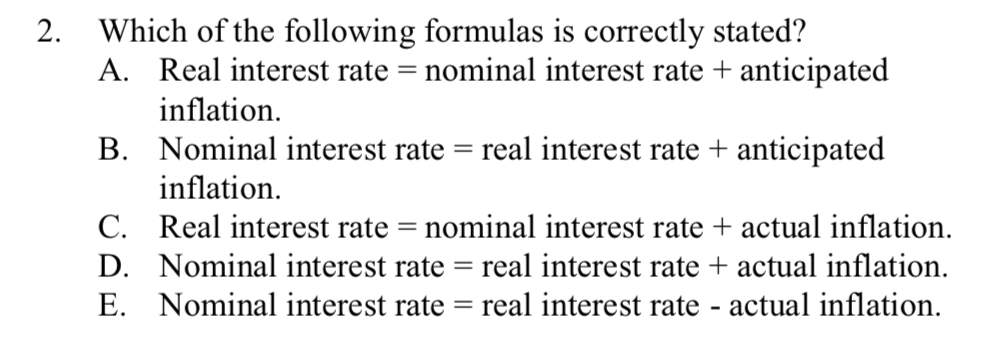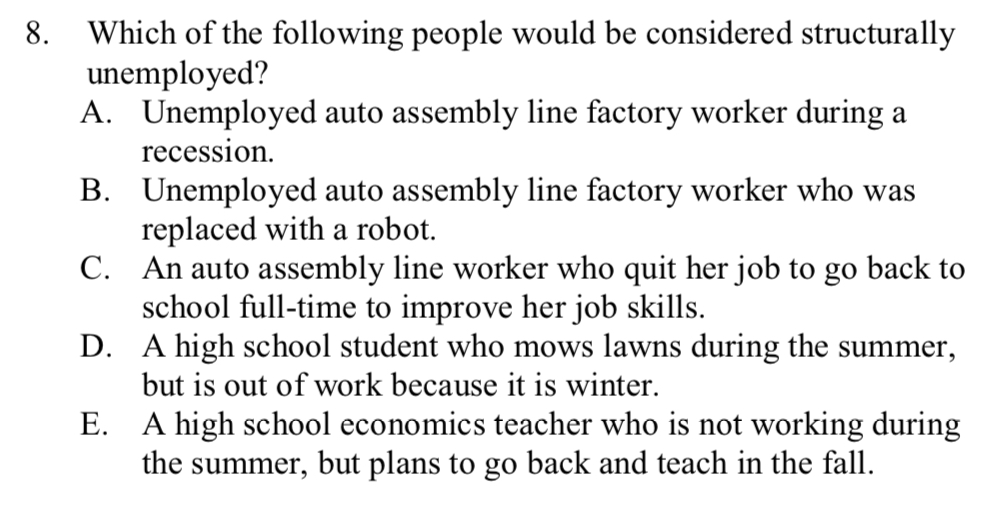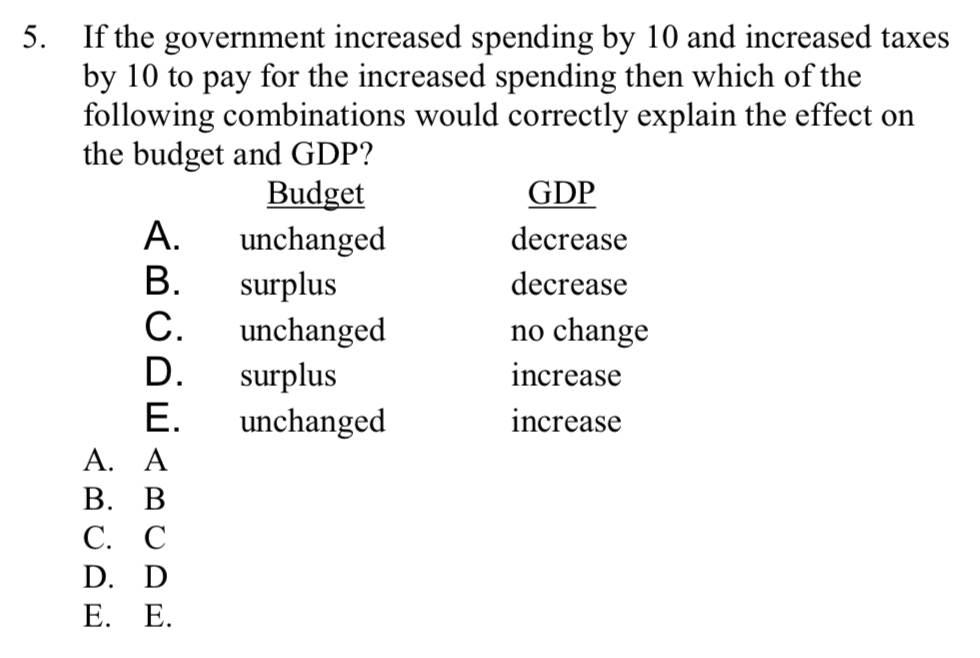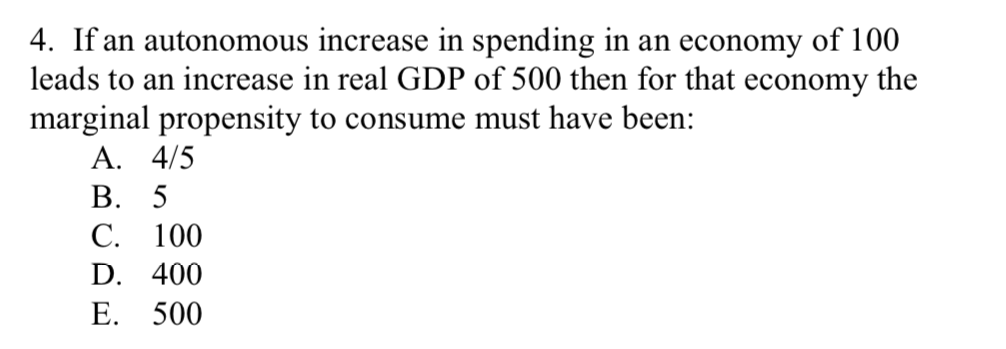aggregate demand & supply
1/43
Earn XP
Name | Mastery | Learn | Test | Matching | Spaced |
|---|
No study sessions yet.
44 Terms
real wealth effect
price rises, dollars buy fewer goods and services, people feel poorer, spending decreases. TLDR; increase in P, causes fall in C & decrease in # of goods and services demanded
interest-rate effect
price rises, takes more dollars to buy g&s, people sell assets for money driving up interest rates.
TLDR; increase in P causes increase in I, smaller # of g&s demanded
what happens to the AD curve when a ten year old investment credit tax expires?
I decreases, shift to the left
what happens to the AD curve when there is a fall in prices that increases the real value of consumers’ wealth?
shift down along AD curve (wealth-effect)
what happens to the AD curve when state governments eliminate sales tax?
C increases, shift to the right
why is the the LRAS vertical?
the natural rate of output/potential output/full-employment output is not influenced by price, and is influenced only by labor, capital, and level of technology
example scenarios of shifts in LRAS
baby boom generation retires, long-term supply decreases, LRAS shifts left
new government policies reduce the natural rate of employment, the % of the labor force employed increases, LRAS shifts right
LRAS shifts from human/physical capital
investment in factories or equipment, capital rises, LRAS shifts right
more people get degrees, capital rises, LRAS shifts right
natural disasters destroy factories, capital decreases, lRAS shifts left
LRAS shifts from changes in natural resources & technology
change in weather patterns makes farming more difficult, LRAS shifts left
discovery of new minerals, LRAS shifts right
reduction in supply of imported resources such as oil, LRAS shifts right
technological advances that allow more output to be produced from given inputs, LRAS shifts right
SRAS
(over a period of 1-2 years), increase in P causes increase in g&s supplied
sticky wage theory
wages take time to change
if price level > price expected, firms increase output and employment
higher price causes higher output
SRAS curve slopes upward
increase in price level causes decrease in unemployment (more employment)
decrease in price level causes increase in unemployment (less employment)
LRAS vs SRAS
if AS is vertical, changes in AD don’t cause changes in output and employment (LRAS)
if AS slopes up, changes in AD cause changes in output and employment (SRAS)
consumer spending (AD curve)
positive outlook (shift right) negative outlook (shift left), tax increase (shift left), income increase (shift right)
investment spending (ad curve)
positive expectations (shift right), negative expectations (shift left), lower interest rates (shift right), higher interest rates (shift left)
government spending (ad curve)
increase in spending (shift right), decrease in spending (shift left)
net exports (ad curve)
increase in exports from weakened domestic currency (shift to right), decrease in exports from strengthened domestic currency (shift to left)
monetary policy (ad curve)
increase in money supply (lowers interest, shift to right), decrease in money supply (increases interest, shift to left)
factors that increase AD (shift to right)
higher consumer/business confidence
increased government spending
higher exports/lower imports
increased money supply (reduced interest rates)
factors that decrease AD (shift to left)
lower consumer confidence
lower disposable income
decreased government spending
lower exports/higher imports
decreased money supply (higher interest rates)
factors that increase AS (shift to right)
decreased input prices
increase in productivity
positive supply shocks
lower cost expectations
decrease in taxes
reduced government regulation
factors that decrease SRAS
increased input prices
decrease in producivity
negative supply shocks
expectations of higher costs
increase in taxes
increase in government regulation
when SRAS shifts to the right…
price level 👇, real gdp 👆
when SRAS shifts to the left…
price level 👆, real gdp 👇
when AD shifts to the right…
price level 👆, real gdp 👆
when AD shifts to the left…
price level 👇, real gdp 👇
when LRAS shifts right…
price level stays the same, real gdp up👆
when LRAS shifts left…
price level👆, real gdp 👇
multiplier effect
1/1-MPC
example: if the MPC is 80%, then the multiplier would be 1/1-0.8, = 1/0.2=5

which of the following formulas is correctly stated?

which of the following people would be considered structurally unemployed?
which of the following describes the components of aggregate demand?
C + I + G + (exports-imports)
formula for nominal interest rate
real interest rate + anticipated inflation rate

which of the following would not affect the size of real gdp?
D, consumer purchase of a rare painting
why: not newly produced (read CAREFULLY)

if the government increased spending by 10 and increased taxes by 10 to pay for the increased spending then which of the following combinations would correctly explain the effect on the budget and GDP?
E, budget unchanged, real gdp increases
why: government spending directly increases demand

if a 100 dollar increase leads to a 1000 dollar increase in the money supply, the reserve requirement must have been
B, 10%
why:
multiplier = 1/reserve requirement
money creation = initial deposit x multiplier
reserve requirement = 1/multiplier
10=1/rr
rr=1/10=0.10=10%

if an autonomous increase in spending in an economy of 100 leads to an increase in real GDP of 500 then the marginal propensity to consume must have been…
A, 4/5 or 0.8
multiplier = 1/1-mpc
multiplier= change in gdp/change in spending, 500/100=5
5=1/1-mpc
1=5(1-mpc)
mpc = 4/5
fiscal policy
who controls it: congress and president
what: managing taxes and government spending
expansionary fiscal policy (boosts economy)
lowering taxes: people have more disposable income to spend
increased government spending: direct increases why in demand, more jobs
contractionary fiscal policy (fights inflation)
raising taxes: people spend less
decreased government spending: less money circulating, aggregate demand directly decreases
monetary policy
who controls it: the federal reserve
what: buying/selling bonds, reserve requirements (how much banks must hold), discount rate (interest rate for banks)
expansionary monetary policy (boosts economy)
lowering interest rates: borrowing is cheaper, more investments and consumer spending
buying government bonds: increases money supply for more spending
contractionary monetary policy (fights inflation)
raise interest rates: people invest and spend less
selling government bonds: banks have less money, higher interest rates, less money supply
phillips curve
high inflation = lower unemployment
lower inflation = higher unemployment